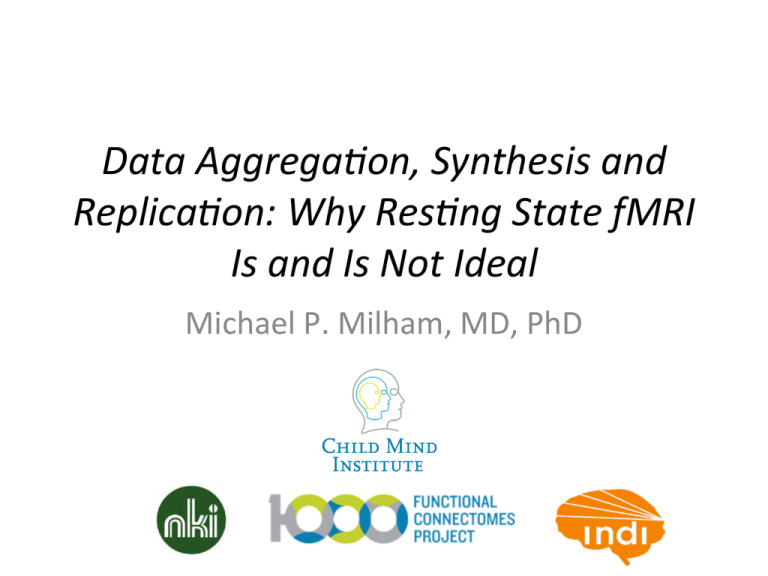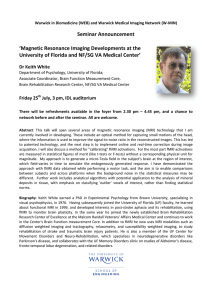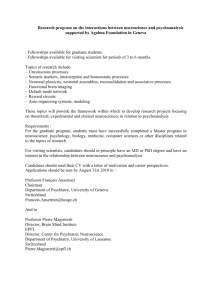Document 13111910
advertisement

Data Aggrega)on, Synthesis and Replica)on: Why Res)ng State fMRI Is and Is Not Ideal Michael P. Milham, MD, PhD What Makes R-­‐fMRI the “Low-­‐Hanging Fruit” for Data AggregaBon? • Bypasses potenBal sources of variaBon associated with task probes • Commonly included as an add-­‐on in task acBvaBon studies – decreases perceived value – Increases willingness to share • Striking similarity in networks observed across laboratories What Makes R-­‐fMRI Less Than Ideal for AggregaBon Yan et al., 2013b Lessons Learned From the FCP/INDI Experience ! http://fcon_1000.projects.nitrc.org #1 Aggregate R-­‐fMRI Data Analysis is Possible Toward discovery science of human brain function Bharat B. Biswala, Maarten Mennesb, Xi-Nian Zuob, Suril Gohela, Clare Kellyb, Steve M. Smithc, Christian F. Beckmannc, Jonathan S. Adelsteinb, Randy L. Bucknerd, Stan Colcombee, Anne-Marie Dogonowskif, Monique Ernstg, Damien Fairh, Michelle Hampsoni, Matthew J. Hoptmanj, James S. Hydek, Vesa J. Kiviniemil, Rolf Kötterm, Shi-Jiang Lin, Ching-Po Lino, Mark J. Lowep, Clare Mackayc, David J. Maddenq, Kristoffer H. Madsenf, Daniel S. Marguliesr, Helen S. Maybergs, Katie McMahont, Christopher S. Monku, Stewart H. Mostofskyv, Bonnie J. Nagelw, James J. Pekarx, Scott J. Peltiery, Steven E. Petersenz, Valentin Riedlaa, Serge A. R. B. Romboutsbb, Bart Rypmacc, Bradley L. Schlaggardd, Sein Schmidtee, Rachael D. Seidlerff,u, Greg J. Sieglegg, Christian Sorghh, Gao-Jun Tengii, Juha Veijolajj, Arno Villringeree,kk, Martin Walterll, Lihong Wangq, Xu-Chu Wengmm, Susan Whitfield-Gabrielinn, Peter Williamsonoo, Christian Windischbergerpp, Yu-Feng Zangqq, Hong-Ying Zhangii, F. Xavier Castellanosb,j, and Michael P. Milhamb,1 a Department of Radiology, New Jersey Medical School, Newark, NJ 07103; bPhyllis Green and Randolph Cōwen Institute for Pediatric Neuroscience, New York University Child Study Center, NYU Langone Medical Center, New York, NY 10016; cFMRIB Centre, Oxford University, Oxford OX3 9DU, UK; dHoward Hughes Medical Institute, Harvard University, Cambridge, MA 02138; eSchool of Psychology, University of Wales, Bangor, UK; fDanish Research Centre for Magnetic Resonance, Copenhagen University Hospital Hvidovre, Hvidovre, Denmark; gMood and Anxiety Disorders Program, National Institute of Mental Health/ National Institutes of Health, Department of Health and Human Services, Bethesda, MD 20892; hBehavioral Neuroscience Department, Oregon Health & Science University, Portland, OR 97239; iDepartment of Diagnostic Radiology, Yale University School of Medicine, New Haven, CT 06511; jDivision of Clinical Research, Nathan S. Kline Institute for Psychiatric Research, Orangeburg, NY 10962; kBiophysics Research Institute, Medical College of Wisconsin, Milwaukee, WI 53226; lDepartment of Diagnostic Radiology, Oulu University Hospital, Oulu, Finland; mDonders Institute for Brain, Cognition, and Behavior, Center for Neuroscience, Radboud University Nijmegen Medical Center, 6500 HB Nijmegen, The Netherlands; nBiophysics Research Institute, Medical College of Wisconsin, Milwaukee, WI 53226; oInstitute of Neuroscience, National Yang-Ming University, Taiwan; pImaging Institute, The Cleveland Clinic, Cleveland, OH 44195; qBrain Imaging and Analysis Center, Duke University Medical Center, Durham, NC, 27710; rDepartment of Cognitive Neurology, Max Planck Institute for Human Cognitive and Brain Sciences, 04103 Leipzig, Germany; sDepartment of Psychiatry and Department of Neurology, Emory University School of Medicine, Atlanta, GA 30322; tCentre for Advanced Imaging, University of Queensland, Brisbane, Australia; uDepartment of Psychology, University of Michigan, Ann Arbor, MI 48109; vLaboratory for Neurocognitive and Imaging Research, Kennedy Krieger Institute, Baltimore, MD, 21205; wDepartment of Psychiatry, Oregon Health & Science University, Portland, OR 97239; xF.M. Kirby Research Center for Functional Brain Imaging, Kennedy Krieger Institute, Baltimore, MD 21205; yFunctional MRI Laboratory, University of Michigan, Ann Arbor, MI 48109; zMcDonnell Center for Higher Brain Functions, Washington University School of Medicine, St. Louis, MO 63110; aaDepartments of Neurology and Neuroradiology, Klinikum Rechts der Isar, Technische Universität München, 81675 Munich, Germany; bbInstitute of Psychology and Department of Radiology, Leiden University Medical Center, Leiden University, Leiden, The Netherlands; ccCenter for Brain Health and School of Behavioral and Brain Sciences, University of Texas at Dallas, Richardson, TX 75080; ddDepartment of Neurology, Washington University School of Medicine, St. Louis, MO 63110; eeDepartment of Neurology, Charité Univesitaetsmedizin-Berlin, 10117 Berlin, Germany; ffSchool of Kinesiology, University of Michigan, Ann Arbor, MI 48109; ggDepartment of Psychiatry, University of Pittsburgh, Pittsburgh, PA 15213; hhDepartment of Psychiatry, Klinikum Rechts der Isar, Technische Universität München, D-81675 Munich, Germany; iiJiangsu Key Laboratory of Molecular and Functional Imaging, Department of Radiology, Zhong-Da Hospital, Southeast University, Nanjing 210009, China; jjDepartment of Psychiatry, Institute of Clinical Medicine and Department of Public Health Science, Institute of Health Science, University of Oulu, Oulu 90014, Finland; kkBerlin NeuroImaging Center, 10099 Berlin, Germany; llDepartment of Psychiatry, Otto-von-Guericke University of Magdeburg, Magdeburg 39106, Germany; mm Laboratory for Higher Brain Function, Institute of Psychology, Chinese Academy of Sciences, Beijing 100864, China; nnDepartment of Brain and Cognitive Sciences, Harvard-MIT Division of Health Sciences and Technology, Massachusetts Institute of Technology, Boston, MA 02139; ooDepartment of Psychiatry, University of Western Ontario, London, ON N6A3H8, Canada; ppCenter for Medical Physics and Biomedical Engineering, Medical University of Vienna, Vienna, Austria; scripts and qqState Key Laboratory Analysis available at of Cognitive Neuroscience and Learning, Beijing Normal University, Beijing 100875, China http://fcon_1000.projects.nitrc.org Edited* by Marcus E. Raichle, Washington University, St. Louis, MO, and approved January 20, 2010 (received for review October 14, 2009) #2 Site-­‐Related Varia<on is Very Real (and poten<ally addressable post-­‐hoc) Biswal et al., 2010 O O F C.-G. Yan et al. / NeuroImage xxx (2013) xxx–xxx Abraham et al., Varoquaux, in prep #3 Site-­‐Related Varia<on Goes Well Beyond Imaging Protocols Di Martino et al., 2010 Nooner et al., 2012 #4 Aggrega<on Promotes Replica<on Functional connectivity density mapping Dardo Tomasia,1 and Nora D. Volkowa,b a National Institute on Alcohol Abuse and Alcoholism, Bethesda, MD 20892; and bNational Institute on Drug Abuse, Bethesda, MD 20892 Edited by Robert Desimone, Massachusetts Institute of Technology, Cambridge, MA, and approved April 21, 2010 (received for review February 4, 2010) Brain networks with energy-efficient hubs might support the high cognitive performance of humans and a better understanding of their organization is likely of relevance for studying not only brain development and plasticity but also neuropsychiatric disorders. However, the distribution of hubs in the human brain is largely unknown due to the high computational demands of comprehensive analytical methods. Here we propose a 103 times faster method to map the distribution of the local functional connectivity density (lFCD) in the human brain. The robustness of this method was tested in 979 subjects from a large repository of MRI time series collected in resting conditions. Consistently across research sites, a region located in the posterior cingulate/ventral precuneus (BA 23/31) was the area with the highest lFCD, which suggest that this is the most prominent functional hub in the brain. In addition, regions located in the inferior parietal cortex (BA 18) and cuneus (BA 18) had high lFCD. The variability of this pattern across subjects was <36% and within subjects was 12%. The power scaling of the lFCD was consistent across research centers, suggesting that that brain networks have a “scale-free” organization. | resting state functional MRI connectivity functional connectomes mode networks scale-free networks consciousness | | | default T overcome the limitations of seed-based approaches for the identification of hubs in the human brain, using resting-state functional connectivity datasets. This ultrafast technique allows calculation of individual functional connectivity maps with higher spatial resolution (≥3 mm isotropic) to take full advantage of the native resolution of the functional MRI datasets. The method is based on the highly clustered organization of the brain (14). Specifically, to speed up the computation of the number of functional connections (i.e., edges in graph theory), we restricted the temporal correlation analysis to the local functional connectivity cluster. Thus, we aimed to determine the location of the functional connectivity hubs in the human brain by using data from the “1000 Functional Connectomes Project” (17), which is a large public database of resting-state time series that were collected independently at 35 sites around the world (http://www.nitrc.org/ projects/fcon_1000/). We further aimed to evaluate the variability of the local functional connectivity density (lFCD) across subjects and imaging parameters as well as its reproducibility within and between subjects. We hypothesized that the lFCD would have low within-subjects variability and that its spatial distribution would be rather constant across research sites in the world. We also hypothesized probability distribution of (PC 1) Fig. 3. Average that spatialthe distribution of the first principal component across a allpower research sites showing the the brain number regions withofhigh lFCD variance the lFCD would have scaling with func10–30%, radiological convention). Scatter plot shows lFCD tional connections(red–yellow: per node, which is the main characteristic of variance as a function of the principal components for each of the sessions of the “scale-free” networks (6),test–retest ratherdataset. than a Poisson distribution, the New York the landmark of random and “small-world” networks (2). o support fast communication with minimal energy cost, cortical brain networks may have few nodes with dense local clustering (hubs) and numerous nodes with an average low number of connections (1–7). The energy-efficient regions (densely conrescaled lFCD was rather constant across these 979 subjects, nected nodes) are thought to serve as the interconnection hubs, Results regardless of differences in demographic variables between Fig. 1 was shows the average distribution of the regions, studies, and statistically significant in all gray matter and neuropsychiatric diseases have been linked to abnormalities in Metaanalysis of FCDM. even whenacross correcting for multiple comparisons atinthethis voxel level lFCD in the human brain all 979 subjects included their configuration (8, 9). However, the investigation of hubs in the with a conservative familywise cingulate error (FWE) threshold PFWE < study. region localized within the posterior cortex/venFig. 2. Spatial distribution of the average lFCD superimposed on A the middle Fig. 1. Spatial distribution of the lFCD superimposed on axial MRI views of brain has(radiological beenconvention). hindered by the cumbersome 0.05 (one-sample t test). Across subjects, the lFCDs in the possagital MRI plane computational for all research sites (green labels) in this study (Table 2). the human brain These maps reflect the average tral precuneus (BAterior 23/31) had the highest lFCD. Regions located in FCDM parameters: T number of functional connections per voxel (k) across 979 subjects from 19 cingulate/ventral precuneus and parietal hubs were 8.5 ± requirements of comprehensive analytical methods. = 50 and T = 0.6. research sites around the world. Green labels indicate the axial distance to the cuneus, inferior parietal cortex, middle occipital, cingulate, SNR C sub mo fol Th dit sub cen Tes FC (N lat eta ca the hig the for fer glo Co the 20 spa ac of tha 12 RO lFC mo to ult Developmental Effects S/P Volume Censoring and Mean FD Matching Fair et al. Differentiating ADHD subtypes with rs-fcMRI FIGURE A2 | Site-by-site histograms of Euclidean distance for functional connections identified in the whole group analysis that get stronger with age and those that get weaker with age (FDR corrected) using procedure 8. stay still, and fixate on a standard fixation-cross in the center of the display. Kennedy Krieger Institute Participants were scanned using a 3.0 Tesla Philips scanner with Fair et al., 2012 A comprehensive assessment of regional variation in the impact of head micromovements on functional connectomics Chao-Gan Yan a, b, c, Brian Cheung b, Clare Kelly c, Stan Colcombe a, R. Cameron Craddock b, d, Adriana Di Martino c, Qingyang Li b, Xi-Nian Zuo e, F. Xavier Castellanos a, c, Michael P. Milham a, b,⁎ a Nathan Kline Institute for Psychiatric Research, Orangeburg, NY, USA Center for the Developing Brain, Child Mind Institute, New York, NY, USA c The Phyllis Green and Randolph Cowen Institute for Pediatric Neuroscience, New York University Child Study Center, New York, NY, USA d Virginia Tech Carilion Research Institute, Roanoke, VA, USA e Key Laboratory of Behavioral Science, Laboratory for Functional Connectome and Development, Magnetic Resonance Imaging Research Center, Institute of Psychology, Chinese Academy of Sciences, Beijing, China b a r t i c l e i n f o Article history: Accepted 5 March 2013 Available online 15 March 2013 Keywords: Head motion correction Resting-state fMRI Voxel-wise movement Test–retest reliability Functional connectomics a b s t r a c t Functional connectomics is one of the most rapidly expanding areas of neuroimaging research. Yet, concerns remain regarding the use of resting-state fMRI (R-fMRI) to characterize inter-individual variation in the functional connectome. In particular, recent findings that “micro” head movements can introduce artifactual inter-individual and group-related differences in R-fMRI metrics have raised concerns. Here, we first build on prior demonstrations of regional variation in the magnitude of framewise displacements associated with a given head movement, by providing a comprehensive voxel-based examination of the impact of motion on the BOLD signal (i.e., motion–BOLD relationships). Positive motion–BOLD relationships were detected in primary and supplementary motor areas, particularly in low motion datasets. Negative motion–BOLD relationships were most prominent in prefrontal regions, and expanded throughout the brain in high motion datasets (e.g., children). Scrubbing of volumes with FD > 0.2 effectively removed negative but not positive correlations; these findings suggest that positive relationships may reflect neural origins of motion while negative relationships are likely to originate from motion artifact. We also examined the ability of motion correction strategies to eliminate artifactual differences related to motion among individuals and between groups for a broad array of voxel-wise R-fMRI metrics. Residual relationships between motion and the examined R-fMRI metrics remained for all correction approaches, underscoring the need to covary motion effects at the group-level. Notably, global signal regression reduced relationships between motion and inter-individual differences in correlation-based R-fMRI metrics; Z-standardization (mean-centering and variance normalization) of subject-level maps for R-fMRI metrics prior to group-level analyses demonstrated similar advantages. Finally, our test–retest (TRT) analyses revealed significant motion effects on TRT reliability for R-fMRI metrics. Generally, motion compromised reliability of R-fMRI metrics, with the exception of those based on frequency characteristics — particularly, amplitude of low frequency fluctuations (ALFF). The implications of our findings for decision-making regarding the assessment and correction of motion are discussed, as are insights into potential differences among volume-based metrics of motion. © 2013 Elsevier Inc. All rights reserved. HarmonizaBon Needs Beyond AggregaBon: Preprocessing • Lack of consensus regarding opBmal preprocessing (Craddock et al., 2013) – Nuisance signal correcBon • Physiologic signals • MoBon signals • Scanner arBfacts – RegistraBon approaches/algorithms – Temporal filtering – Slice-­‐Bming Preprocessed INDI Data in the Cloud • Available through S3 Bucket generously provided by AWS • Raw INDI will be available soon h]p://preprocessed-­‐connectomes-­‐project.github.io/ Craddock et al., in prep Analysis of Connectomes: Pipeline for the Analysis ctomes (C-PAC) Craddock et al., in prep PCP Quality Assessment Protocol • SpaBal Measures – Contrast to Noise RaBo – Entropy Focus Criterion – Foreground to Background Energy RaBo – Smoothness (FWHM) – % ArBfact Voxels – Signal-­‐to-­‐Noise RaBo • Temporal Measures – – – – – Standardized DVARS Median distance index Mean FuncBonal Displacement # Voxels with FD > 0.2m % Voxels with FD > 0.2m h]p://preprocessed-­‐connectomes-­‐project.github.io/quality-­‐assessment-­‐protocol/ Craddock et al., in prep Beyond AggregaBon: Synthesis • AnalyBc VariaBon – A growing plethora of approaches – Even for same approach, marked variaBon can exist • Seed-­‐based correlaBon approaches • Parameter specificaBon – ICA – Graph theoreBcal approaches – Cluster analysis • ReporBng variaBons – Inherent to all of fMRI That’s all Folks!







